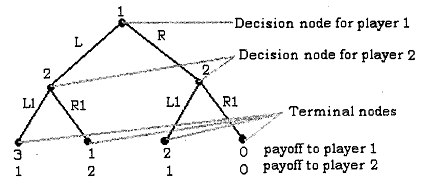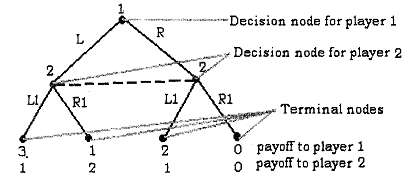Extensive Form Games:
In the previous section we discussed normal form game, which is mostly used to represent static games. Now we will discuss how to represent dynamic games. Dynamic games are mostly represented in extensive form. This kind of expositional approach may make it seem that static games must be represented in normal form and dynamic games must be represented in extensive form, but this is not the case. Any game can be represented in either normal or extensive form, although for some games one of the two forms is more convenient to analyse.
Definition: The extensive form representation of a game specifies
1) the players in the game.
2) a) when each player has to move
b) what each players' choices are when they move
c) the knowledge of each player at each of opportunity to move
3) the payoff received by each player for each combination of moves that could be chosen by the players.
The contribution of extensive form representation is that games are represented using games trees rather than words, which makes it easy and simpler to analyse.
As an example of a game in extensive form consider the following:
Example: Player 1 chooses an action a, from the feasible set A1= {L, R); player 2 observes a, and then chooses an action a2 from the feasible set A2= {L, R). Payoffs of the players are u1 (a1, a2) and u2 (a1, a2), as shown in the following game tree

The game tree begins with a decision node for player 1, where 1 chooses between L and R. If player 1 chooses L, then a decision node for player 2 is reached, where 2 chooses between L1 and Rl . Following each of the player 2's choices, a terminal node is reached (the game ends) and the players receive their payoffs.
It is straightforward to extend the game tree in the above figure to represent any dynamic game of complete and perfect information (that is, any game in which the players move in sequence, all previous moves are common knowledge before the next move is chosen, and the players payoff from each feasible combination of moves are common knowledge). Games with continuous strategy spaces present graphical difficulties, not conceptual.
Dynamic games of incomplete and perfect information can also be represented in extensive form (that is, the games where players do not know what move was taken by the others in the previous step but the payoffs from each feasible combination of moves are common knowledge). For that we need to define few terms. Suppose y is a node in an extensive form game and A (y) is the set of actions available at node y to a particular player. Let us suppose that in the previous example, player 2 does not know what decision has been taken by player 1, that is, player 2 does not know which one of L and R has been taken by player I. In that case, player 2 is not sure in which node she exactly is, she could be in the left node if player 1 chooses L otherwise in the right node if player 1 chooses R. This is called the situation of imperfect knowledge. But as both the players know the payoff that is going to accrue to each of them it is a game of complete information. We represent these types of games in extensive form in the following way.

The dotted line joining nodes of player 2 indicates that player 2 does not know in which node she is. To represent this type of ignorance of previous moves in an extensive form games, we introduce the notion of player's information set.